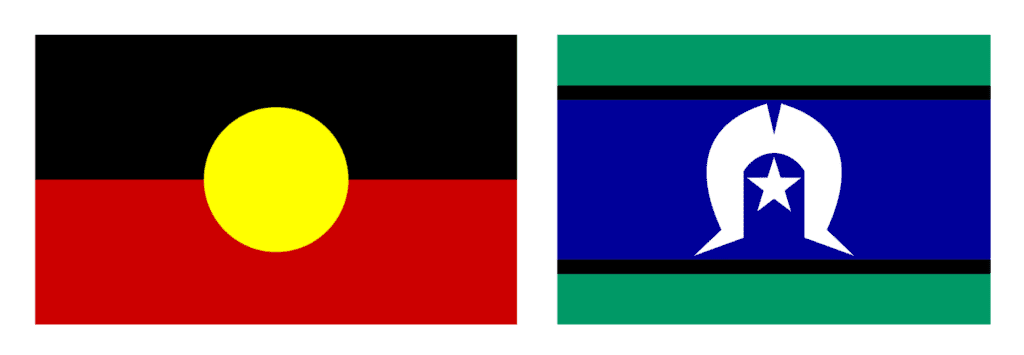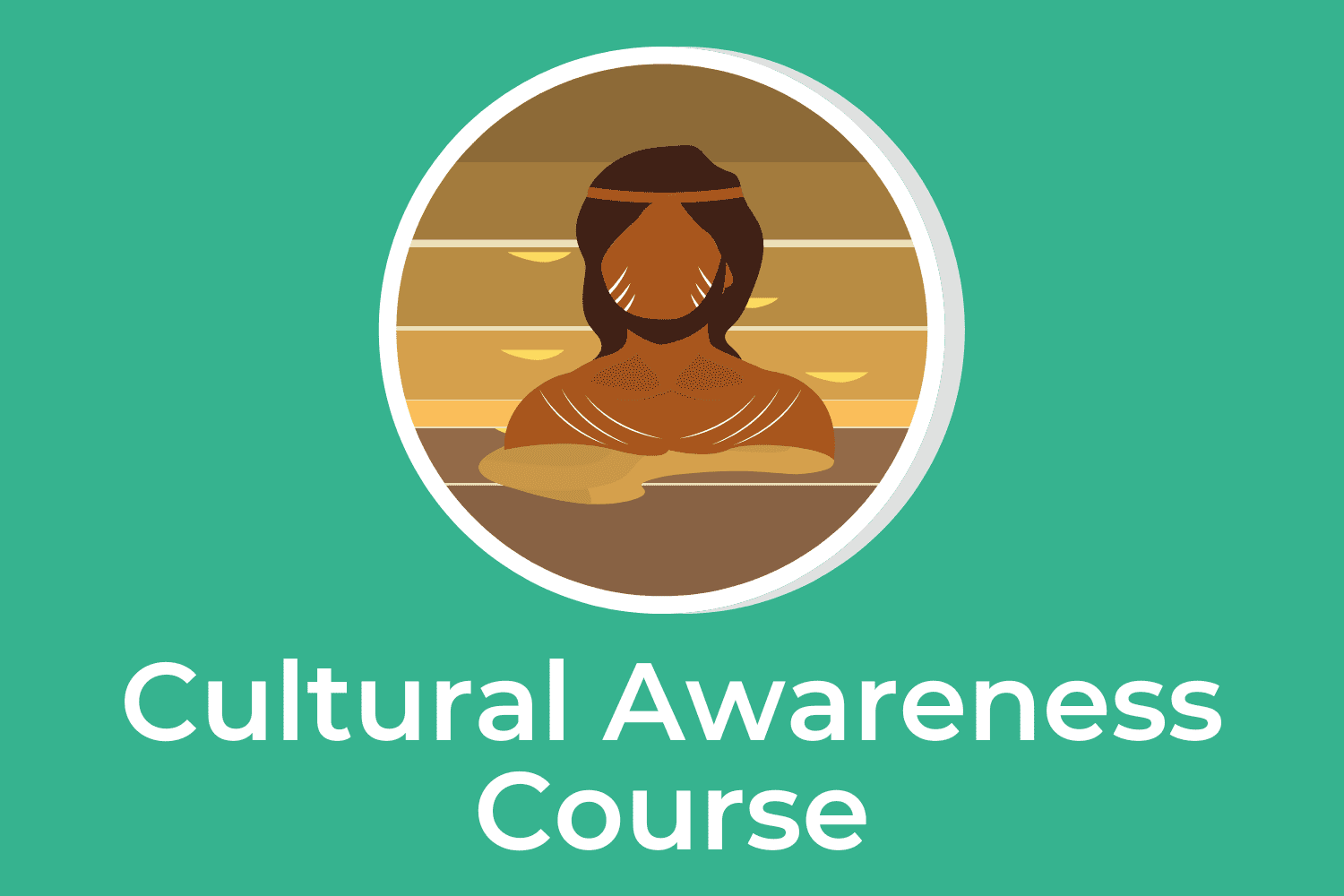Foundational Knowledge
Did you know there are TWO Indigenous groups in Australia?
The first is Aboriginal and the second is Torres Strait Islanders. These two groups make up Indigenous Australia.

The Aboriginal Flag was designed in 1971 by Harold Thomas, an Aboriginal man from Central Australia. He chose the colour black to represent the skin colour of early Aboriginal people, red to represent ‘mother earth’ or ‘Country’, which in Central Australia is red ochre, and a yellow circle to represent the sun, the giver and re-newer of life. The flag has now become an iconic symbol of the Aboriginal people.
The Torres Strait Islander Flag was designed in 1992 by Bernard Namok from Thursday Island after winning the best design in a competition with the council. In the middle of the flag is a white dhari, which is a cultural headdress used in traditional dances performed by the Islanders on special occasions. The star in the middle of the flag represents peace and the importance of stars in the night, helping the Islanders navigate from one island to another. The tip of each star represents the five major Islander groups in the Torres Strait Islands. Green represents the islands, blue represents the waters, and black represents the skin colour of the early Torres Strait Islander people.
INSERT IMAGE OF ABORIGINAL AND TORRES STRAIT PEOPLE
Aboriginal people have lived on the main continent of Australia for 40,000 – 120,000 years, depending on what research is accessed.
Traditionally, Aboriginal people refer to the land their families are from as ‘Countries‘ or ‘their Country‘ and this is because there are over 600 hundred different Aboriginal countries throughout the continent of Australia.
Each country may have its own language, in fact there are over 250 aboriginal language groups, 800 dialects, customs and protocols.
Meaning rules change, just like our states and territories do, but hundreds of times, not just 8 times.
Like many of us, the aboriginal people have both a physical and a spiritual connection to the land that resonates deep, connecting them to their ancestors who lived on the same land before them.
INSERT MAP OF DIFFERENT TRIBES/COUNTRIES
The Torres Strait Islands, home to the Torres Strait Islander people, are located in the 48,000kms of water that separates the northern borders of Queensland and the Southern Coast of Papua New Guinea.
There is a phrase and documentary ‘Ailan Kastom’ meaning ‘Island Custom’, and is about the traditions, dance, music, art, language and beliefs of the Torres Strait Islander people.
The Torres Strait Islands is made up of over 250 small Islands, with approximately 18 being inhabited. The Islands are surrounded by beautiful clear seas and lush green landscapes. The main island, Thursday Island with a census in 2016 recognising just under 3,000 people, has the largest population.

The word ‘Aborigine’ is a Latin word that means a person, animal, or plant that has been in a country or region from earliest times or ‘from the beginning’ and was given to Australia’s First Nations people by settlers in the late 1700’s. Traditionally the word Aborigine was used to describe people of an area before they were invaded or colonised.
Today this term ‘Aborigine’ has become so familiar that it is now accepted by most modern-day Aboriginal people, in addition to their traditional Country name which you will hear many people introduce themselves by.
For example ‘ My name is Joe, and I am a proud man from ‘Dharawal country and am a member of the Cubbitch Barta Tribe’.
The name Torres Strait Islands was named after Spanish ship Captain, Luis Baes De Torres, who sailed through the Torres Straits in 1606 on his way to the Philippines.
There is no right or wrong as to what to call someone, but to name them what they wish to be called.
Communication and connection to all of the human race is key for a healthy, safe and respectful relationship.
To be respectful to the different countries and or tribes in Australia, you should always ask local Indigenous Australians what is the appropriate term in that area.
INSERT IMAGE OF TOGETHERNESS AND EQUALITY
In the 1980s, the Commonwealth government created a definition for Aboriginal and Torres Strait Islander peoples.
According to the government, an Aboriginal or Torres Strait Islander is:
- A person of Aboriginal or Torres Strait Islander descent;
- One who identifies as being of Aboriginal or Torres Strait Islander origin; and
- Accepted as such, by the community with which the person associates. Meaning they are an active part in their local land council or other community groups.
This can be very upsetting to many and there has been widespread controversy, even within Indigenous circles, of these definitions and what processes it has attracted over the last four decades.
Some people must provide evidence of their aboriginality for employment and other reasons, this is often difficult emotionally for many reasons.
In 2021, Aboriginal and Torres Strait Islander people made up approximately 3.2% or 812,000 of the Australian population. Based on the Australian Bureau of Statistics (ABS) projections, the number of Indigenous Australians in 2022 was estimated to be 903,072.
Fun Facts –
- Around 91% of Indigenous people identify as Aboriginal.
- Around 4.8% of Indigenous people identify as Torres Strait Islanders.
- Around 4% of Indigenous people identify as both Aboriginal and Torres Strait Islander.
Indigenous Australians live in all parts of the nation, from our cities to remote, tropical and desert areas.
Most aboriginal people live in urban and regional areas compared to remote locations. Based on past and current data for 2021, Indigenous Australians can be found in the following:
- 38% live in major cities.
- 44% live in inner and outer regional areas.
- 18% live in remote and very remote areas.
- 61% of Aboriginal people live in New South Wales and Queensland.
- 13% live in Western Australia, and a smaller percentage live in every other state except the Northern Territory.
- Almost 1 in 3 people in the Northern Territory are Indigenous Australians.
- 80% of Torres Strait Islanders live outside the Torres Strait.
It is now common for different Indigenous groups to have a more general name outside of their traditional Country name. This is commonly linked to a geographical state or region. Some include:
- Murri – Qld, North West NSW
- Nyoongah – WA
- Koori – NSW
- Goori – North Coast NSW
- Koorie – Victoria
- Ngarrindjeri – SA
- Palawa -Tas
- Yolngu – Arnhem Land
- Anangu – Central Australia
- Torres Strait Island peoples
These names are appropriate for the areas where they apply. However, local Indigenous Australians can clarify the appropriate use of these and any other appropriate terms.
Watch the video below:
As humans we are all different, different hair colour, skin colour, personality etc. Indigenous Australians are of course all different too, as in the above video. It is important to note that despite skin colour, people can identify as either Aboriginal or Torres Strait Islander or both.
As seen in the videos and pictures throughout this course, there are varying shades of skin colour though they all identify as Indigenous Australians.
Labelling Indigenous individuals with titles such as half-caste or quarter-blood can be taken as an insult. All Indigenous people who identify as Aboriginal and/or Torres Strait Islander take pride in their Indigenous culture and history, despite the colour or shade of their skin as with all other cultures.
Sources:
Flags of Indigenous People – Department of the Prime Minister and Cabinet
Regional Map – www.tsra.gov.au
AIATSIS – Living languages
National Geographic – https://www.nationalgeographic.com/culture/article/aboriginal-australians
NITV – https://www.sbs.com.au/nitv/article/10-things-you-may-not-know-about-the-torres-strait-islands
ABS – https://www.abs.gov.au/articles/australia-aboriginal-and-torres-strait-islander-population-summary
